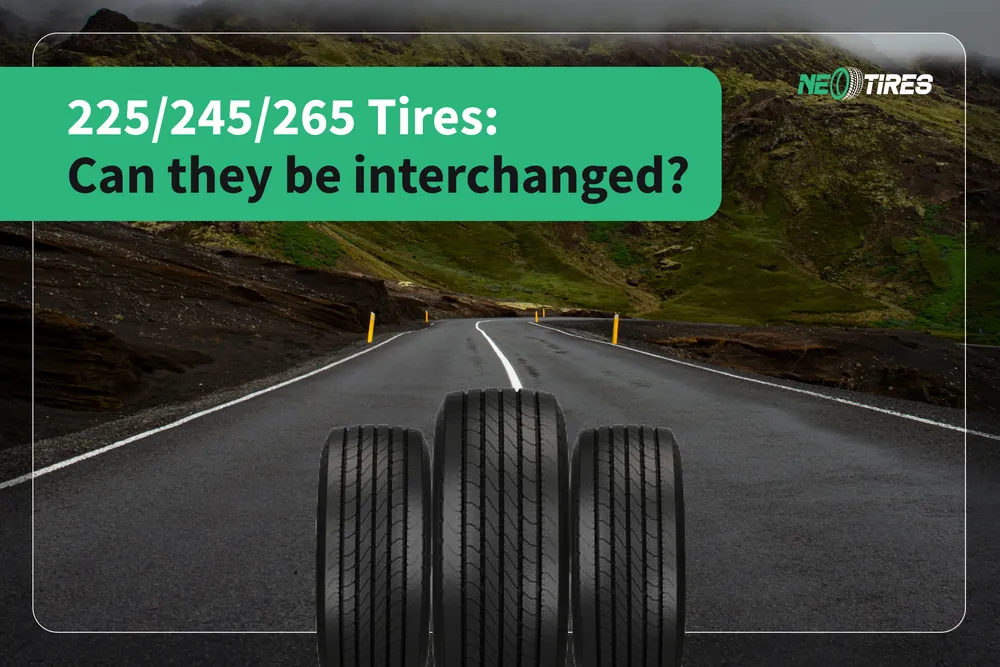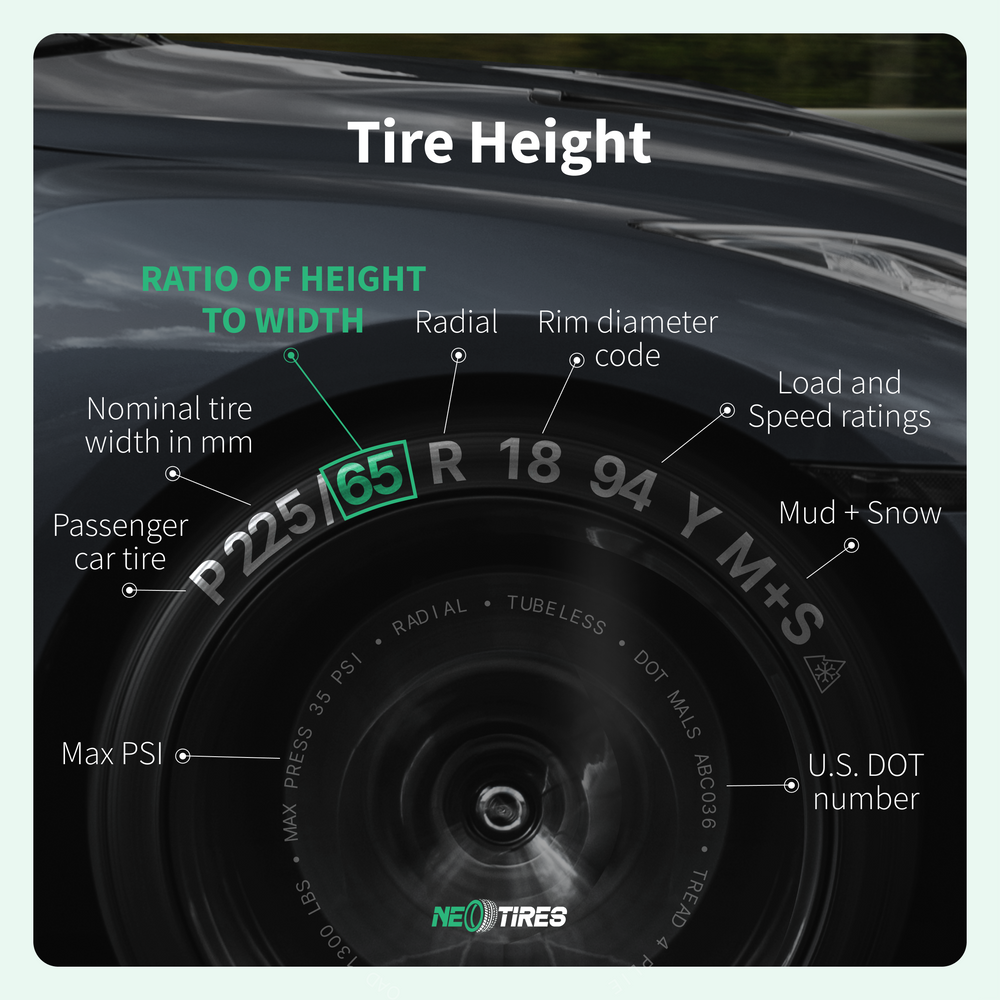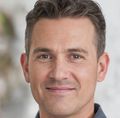The most popular tires are 225, 245, and 265 inches. They share many common aspects, so drivers face difficulty choosing the correct size. As a rule, these sizes are specific to passenger vehicles and SUVs.
The right size is one of the most essential aspects of choosing the right tires. Once you know what makes them different, you will know whether it is a good idea to interchange them and what the potential benefits or side effects are. So, let's hit the road, shall we?
225/ 245/ 265 Tires: Any Difference?
Yes, there are several differences between these tire sizes, which include sidewall height, tire width, resistance to additional load, rolling resistance, grip, traction, and comfort. Drivers should pay attention to tire size and all these additional aspects when it comes to a set of new tires.
For example, going from a size of 225 to 265 inches, you can expect a higher rolling resistance, which means less efficient fuel consumption. In other words, the performance of these tires is generally different even if the size difference is not very big. Take a look at the infographic below to create a clearer picture:
Tire Height (Aspect Ratio)
The 225, 245, and 265 tires differ not only in size but also in height. The 225-size tire is the lowest, whereas the 265-size tire is the highest. Even if the difference in height does not seem significant, it defines how the tires perform on various roads and in various weather conditions. If a driver needs better stability and more confident traction, he should choose taller tires.
Sidewall Height
The tire's height is closely related to the height of its sidewall. The sidewalls of the tire are very durable but also very elastic. These determine the cushioning effect during riding.
The higher the tire, the more expressive the cushioning effect. For this reason, the 265-inch tires are a favorite for those who want a smoother ride. These are about 8mm higher than their 225 and 245'' rivals. The difference has enough impact on comfort and cornering stiffness.
Tire Width
A wider tire means a larger contact patch with the road, meaning more stable balance, especially during cornering or braking. The 265-inch tire behaves much more stably on various road surfaces. The 20mm difference between a 265 and a 225 tire is enough to generate more confidence in agile maneuvers and more confident traction.
A wider tread ejects water from its path more tenaciously, reducing the risk of hydroplaning. As for the narrower tires like the 225'', they do well on slippery roads but not as well as wider ones. These provide a reduced grip as the contact patch with the road is smaller.
Still, narrower tires are more fuel-efficient than wider ones.
Tire Rolling Resistance
The rolling resistance of tires of different sizes (225, 245, and 265) is different. The 225-inch tire is the most optimal. This is because there is less rubber on the road, which means less engine energy is required to roll the tire forward.
The 265 tires need more power and energy to be rolled forward. Consequently, the rolling resistance of a 265'' is generally higher.
Load Rating
Different tire sizes mean different load ratings. The 265-inch tire is the most resistant to stress and additional weight of the three. Drivers who are used to loading the vehicle with additional weight must necessarily opt for larger tires. The construction of the 265-inch tires is stronger than that of the 225-inch tires, for example. As such, they will withstand the weight better.
A tire that carries more than it can according to its load rating is subject to uneven wear and premature damage. In addition, carrying more than the tire can withstand goes against safety rules. The 225 and 245 tires are great options if the driver does not usually load the vehicle too much. The load rating chart will help you understand how much a tire can carry depending on its size. Take a look.
Can 225 and 245 Tires Be Interchanged?
It is possible to interchange 225 and 245 tires whenever sticking to the same rim diameter and aspect ratio. This means that the 225'' size tire with a 70R16 aspect ratio, for example, should be changed to a 245 with the same 70R16 aspect ratio.
Upgrading from 225 to 245 tires will benefit drivers. These include better handling, enhanced traction, and more prominent grip, especially in more challenging conditions. In addition, thanks to better shock absorption, drivers can expect a more comfortable ride. Last but not least, the vehicle will become more resistant to additional cargo.
The main benefit of downgrading from 245 tires to 225" tires is improved fuel consumption. Before any modification, whether size down or upgrade, it is advisable to consult a specialist.
Can 245 and 265 Tires Be Interchanged?
Technically, these two tire sizes can fit on the exact vehicle. However, tires of 245 and 265 sizes usually have different widths and aspect ratios. The width differs by about 10mm in favor of the 265'' tire. Also, there is a difference of 5 units between these tires' aspect ratios, which means 65 for the 245 tires and 70 for the 265''.
Despite these minor differences, the change from one tire to another takes place without significant issues. In some cases, downgrading from 265 to 245 '' can lead to errors in the speedometer reading and small performance changes, especially during cornering.
In the same context, 265-inch tires can also fit a vehicle with 245-inch OE tires without problems. However, the specialist must ensure that the 265-inch tire is not too big for the vehicle and does not affect the hood line or fenders during installation. Therefore, it is advisable to consult a specialist before making any changes.
Can 225 and 265 Tires Be Interchanged?
Generally, switching from 225 to 265 or vice versa should not be a big problem. This switching scheme is accepted whenever both tires have the same rim diameter and aspect ratio. Drivers often report that the most significant change they feel is the vehicle sitting lower than usual (in case of a downgrade). Also, performance aspects like handling, traction, and responsiveness are slightly altered.
Considering the upgrading scenario, it is likely that the car wheel wells and fenders will need to be adjusted to fit a larger size. In this context, upgrading also requires new rims and wheels to be compatible with the suspension and the new larger tire. In this sense, a consultation with the specialist before the procedure is a good idea.
FAQs: Can 225/245/265 Tires Be Interchanged?
Is There A Big Difference Between 245 and 265 Tires?
These two tires differ in width and height, with a difference of about 20 mm in width and 7 mm in height, respectively. The additional clearance also differs, assuming half the 7mm extra height. Finally, depending on your tire type, these two tires will differ in tread depth.
What Does a 265 Tire Equal To?
The 265 marking at the beginning of the markings' sequence refers to the tire's width. According to international standards, this is shown in millimeters. To convert it into inches, divide the millimeters by 25.4, the last being the equivalent in inches for one millimeter. Therefore, we get the equation 265/25.4 = 10.4. So, 10.4 inches is the equivalent of a 265 tire.
Can I Put 265 Tires on 245 Rims?
Technically, you can do this only after considering your rims' specs. As a general rule, all tires feature a wheel-width mounting range. In most cases, it's about 1-2 inches. Consequently, your 265 tire also has a rim width mounting range. It depends on the sidewall height aspect ratio and its diameter. It is advisable to consult a mechanic expert before making the switch. He will confirm whether your 245 inches are fully compatible with 265 tires.
Can I Use 255 Tires Instead of 265?
Technically, you can make the switch. However, you should check your wheel width, as this factor determines tire-wheel compatibility. Generally, all tire sizes have a 1-2 inch rim width mounting range. If you're not sure, please consult a mechanic before replacing 265 with 255 tires.
What Size Rim Does a 225 Fit?
The following guide will help you better understand what is the minimum and maximum recommended wheel width for a 225 tire. Take a closer look.
 Will a 245 Fit on an 8-inch Rim?
Will a 245 Fit on an 8-inch Rim?
The 8.5 ''rim would be the perfect match for the 245 tires, but the 8'' ones will also work well.
Bottom Line
Technically, drivers can interchange the tires with 225/245/265 sizes. However, before switching to larger or smaller tires, a driver should consult an expert in the field. Any size change involves handling and tire performance modifications that can mislead the driver, leading to serious risks. In this sense, we recommend doing things correctly and only under the guidance of a specialist. Drive safe and choose tires wisely!
Find the Right Tire Size for Your Vehicle with NeoTires!
Understanding tire size is crucial for performance and safety. Contact us if you're considering a tire size change and are unsure about its fitting.
Explore our wide selection of various tire sizes and find your best partner in crime to hit the road ahead.
Why Trust Neotires?
The Neotires team not only sells tires at the best prices but also dedicates itself to development in this industry. We brought in a team of specialists in the field with extensive experience in the industry who share with us knowledge and safety tips about everything that means rubber. Apart from offering the best tire deals, we are also actively involved in testing processes and reviews in our own "lab."
In this context, we provide professional tire guidance and high-quality tires at the best prices. With us, you can upgrade your driving experience with peace of mind. Drive safe, and choose your tires wisely!










